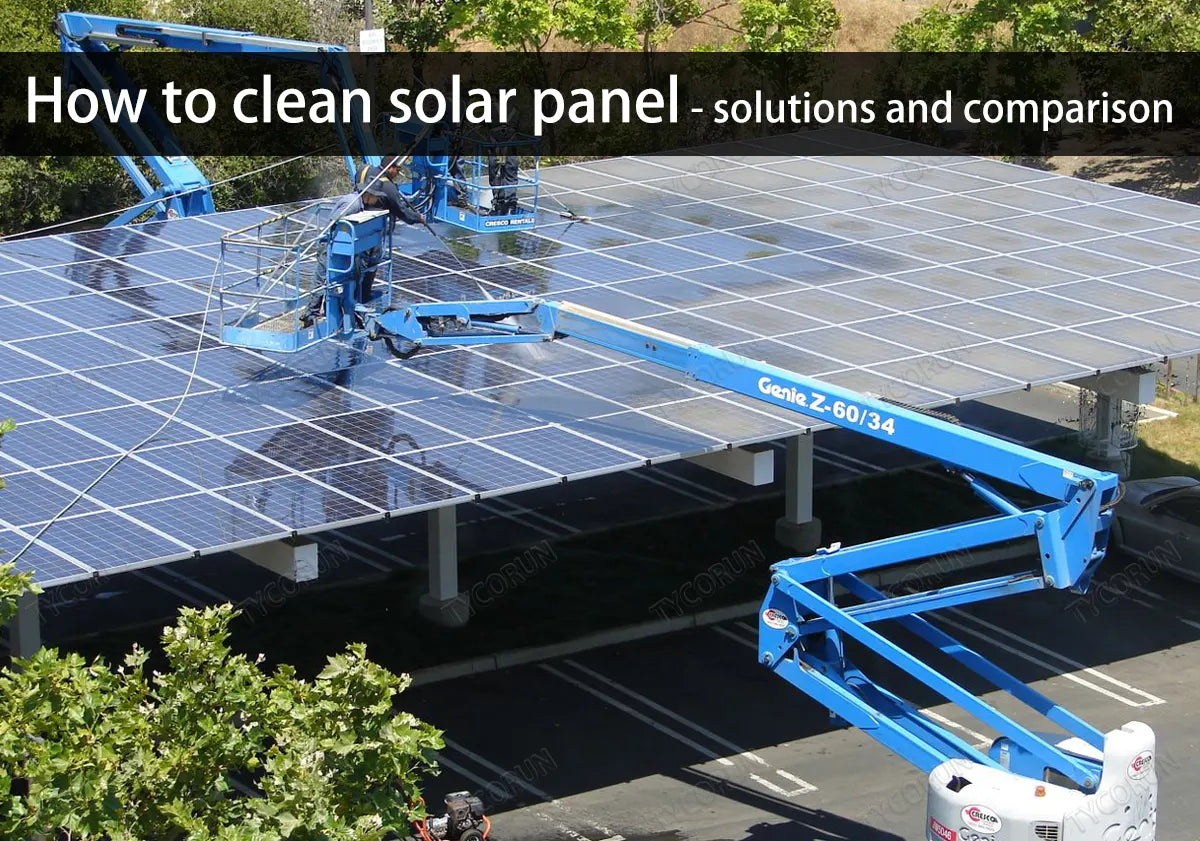
Except for the inverters such as power inverter 2000 or power inverter 3000w, the photovoltaic modules are also the core part and the most valuable part of the photovoltaic system. The quality and the cost of photovoltaic modules will directly determine the quality and cost of the entire system.
Therefore, for the operation and maintenance of solar photovoltaic power stations, it is very important to regularly clean the dust on the surface of solar panels to ensure that the module surface is always clean and the power generation efficiency and module life are maintained. So how to clean solar panel? This article will explain and compare the solutions in detail.
Main content:
1. Why is it necessary to clean solar panels?
The impact of dust on solar panels is mainly reflected in the following aspects:
① Power generation efficiency:
Dust on the surface of solar panels will block the incidence of sunlight and reduce the light absorption capacity of photovoltaic modules, resulting in a decrease in power generation efficiency. The theoretical power generation efficiency of photovoltaic modules is 25%, and the actual power generation efficiency is 23%. When polluted, the power generation efficiency drops to 17-18%.
When photovoltaic modules are installed outdoors, so the dust particles or snow that attached to the surface will affect the transmittance of light, which will in turn affect the amount of radiation received by the module surface and affect the power generation efficiency.
Partially obscured dirt such as soil and bird droppings on the surface will cause cause hot spot on the solar panels, reducing the power generation efficiency and even burn the modules. In order to improve the power generation efficiency of photovoltaic modules, solar panels need to be cleaned regularly.
② Increase the temperature:
Dust will be converted into heat energy after absorbing sunlight on the surface of solar panels, causing the temperature of photovoltaic modules to increase, thereby reducing power generation efficiency.
③ Service life of solar panels:
Long-term accumulation of dust will form a thin film on the surface of solar panels, affecting the surface cleanliness of the modules, resulting in a gradual reduction in power generation efficiency and possibly shortening the service life of the modules. In order to maintain normal power generation efficiency during the service life, it is necessary to know how to clean solar panel.
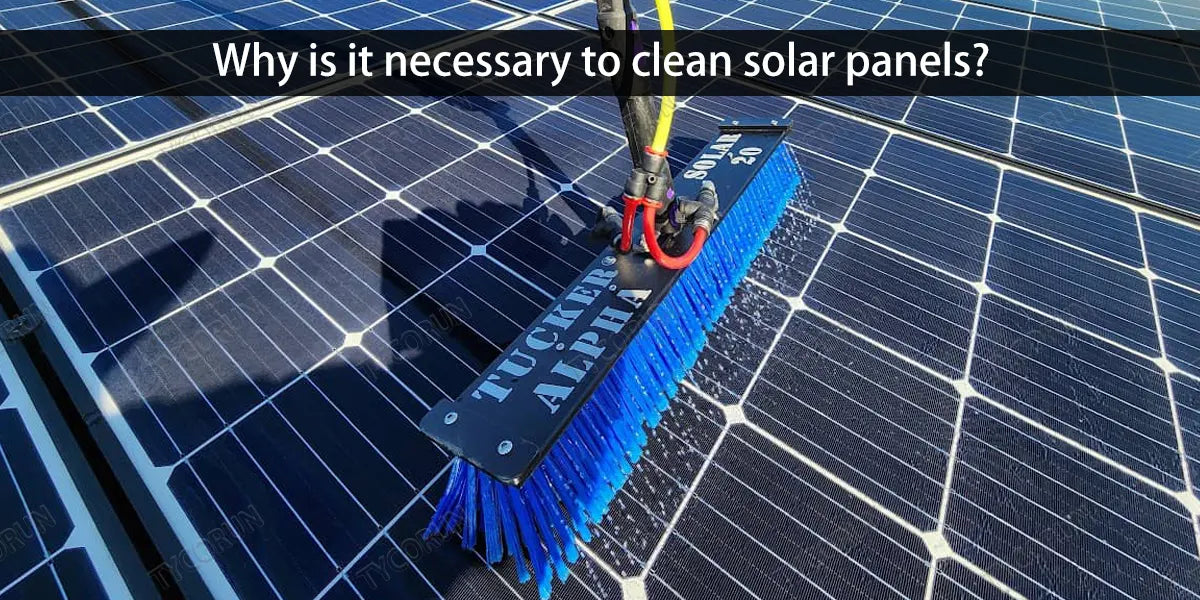
2. Solar panel cleaning technologies
Technologies on how to clean solar panel are divided into manual cleaning and mechanical cleaning according to the degree of intelligence.
- Manual cleaning technology
At present, most photovoltaic power stations are using manual cleaning. When cleaning, usually a group of 2 to 3 people is involved. One of them is responsible for managing the water supply equipment and arranging the water pipes, the other is responsible for flushing the components with a high-pressure water gun, and the third is responsible for cleaning the dusty corners with a mop and drying the components.
With the development of technology, integrated manual cleaning tools have emerged. This tool integrates a high-pressure water nozzle and a rotating brush made of carbon fiber material. This tool has high efficiency, low water consumption, low labor intensity, and low price. Therefore, it is favored by professional photovoltaic power station cleaning companies.
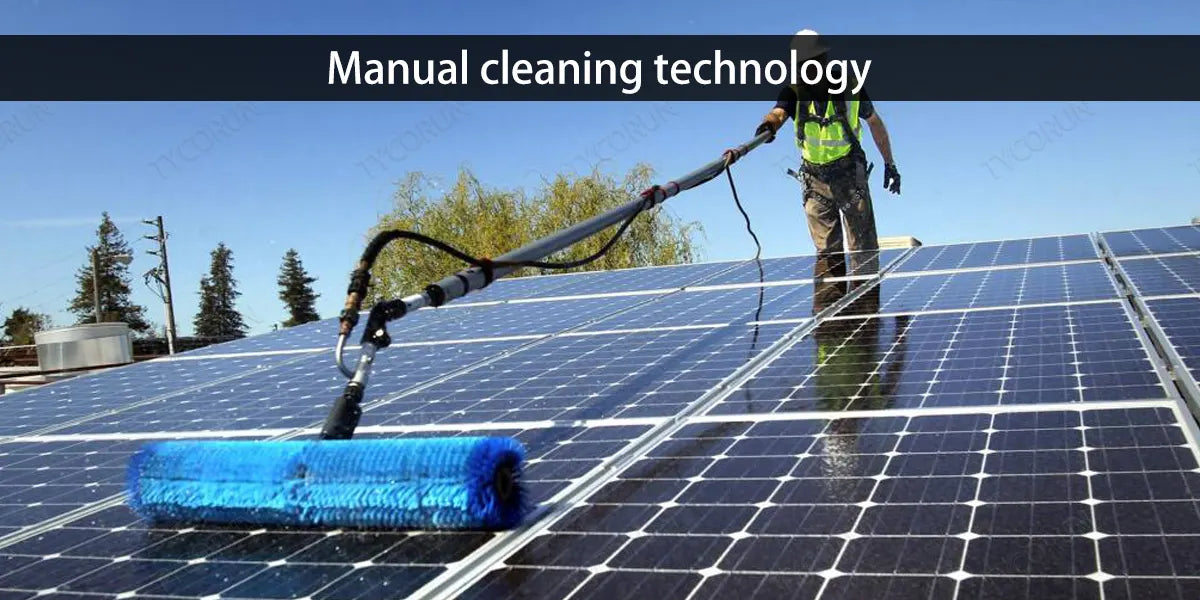
- Mechanical cleaning technology
At present, mechanical technologies on how to clean solar panel can be divided into: single-row cleaning, multi-row cleaning, and large-format cleaning.
① Single-row cleaning technology
Single-row cleaning technology means that the equipment can only complete the cleaning of one row of components and cannot cross rows. This technology has been widely used in various photovoltaic power stations and has the largest number of existing models on the market.
This technology is normally implemented through cleaning robots. The four running wheels of the robot walk along the frame of the component. The brushes in the cleaning part turn in the opposite direction to the traveling direction of the running wheels. During the rotation of the brushes, dust is first removed from the surface of the component, and then the impact of the brushes and the rotating airflow are used.
The dust is driven to the gaps between components and falls off. This type of robot uses a variety of sensor technologies to sense not only the position of the robot, but also the working status of the robot's walking wheels, LFP battery, brushes, etc. Compared with other products, the control system is relatively complex and is easily affected by uncoordinated walking which may get the robot stuck.
② Multi-row cleaning technology
Multi-row cleaning technology can also be divided into the following three types:
A.Vehicle cleaning equipment
After completing the cleaning of one row of components, the engineering vehicle transports the equipment to the next row of components. This technology mostly uses water cleaning. The cleaning device is installed on the engineering vehicle, which has its own water tank and water pump. This type of product is expensive, bulky, and cannot cope with complex terrain. It is mainly suitable for photovoltaic power stations with relatively flat terrain, so it has certain limitations.

B.Cross-row cleaning technology
This technology is not yet mature. At present, this type of equipment has been applied in distributed power stations, and is still in the prototype testing stage in ground power station projects. The main reason is that the roof of the distributed power station is relatively flat and suitable for laying tracks, and the ground power station is located in complex environment and topography, which makes it difficult to lay tracks on a large area.

C.A cleaning robot whose body can realize autonomous steering
This kind of robot completely gets rid of the dependence on the vehicle when crossing the queue. Currently, only a handful of manufacturers have mastered this technology, and prototypes have been used in distributed rooftop power station projects.
Due to the structural particularity of the flat single-axis system ground power station, through ingenious structural design and control methods, the track can be erected in the air as a whole, avoiding the impact of the ground surface on the track. At present, this technology has also begun related prototype testing.
- Large-format cleaning technology
The components of some large distributed power station projects are densely arranged and do not reserve sufficient maintenance channels, so the array width is generally large (usually 10 meters or more). Both single-row and multi-row cleaning equipment cannot be used because the gaps between components are too small and there is insufficient installation space for the limit wheels.
The robot with large-format cleaning technology realizes the steering of the robot through the difference in speed of the walking wheels. This method of how to clean solar panel is similar to other single-row cleaning technologies.
3. Solar panel cleaning solutions
How to clean solar panel
- General dust removal: Under normal circumstances, use a duster or dry mop to clean the dust on the surface of the solar panel to reduce the impact of dust on power generation.
- Partial cleaning: When there are contaminants such as bird droppings that are difficult to remove in a certain part of the photovoltaic array, the photovoltaic array will be partially cleaned with clean water.
- Overall cleaning: When dust accumulates thickly on the surface of the solar panels due to long cleaning intervals or harsh weather, the photovoltaic array needs to be cleaned as a whole. When cleaning photovoltaic area components, natural rainwater cleaning is the first option, and manual cleaning is considered in seasons with less rain.
- A general dusting schedule should be conducted every two weeks, and a general cleaning schedule should be conducted every three months or after a particularly severe weather week.
- Solar panel cleaning should be carried out in the early morning, evening, night or rainy days (when the irradiance is less than 200W/m2). It is strictly forbidden to clean around noon or during periods of strong sunlight. When cleaning in the morning and evening, you should also do it during the period of dim sunlight.
How to clean solar panel modules
Common methods on how to clean solar panel modules include the following two types:
- Manual cleaning
Manual cleaning is the original module of how to clean solar panel, which is completely dependent on human power. This method of how to clean solar panel has low working efficiency, long cleaning cycle, high labor cost, and hidden risks. It is mainly divided into manual washing and manual dry cleaning.
① Manual washing
Manual water washing uses a nozzle connected to a water tanker (or water pipe) to spray water on the surface of the solar panel to achieve the desired effect. For the purpose of how to clean solar panel, this cleaning method is better than manual dry cleaning, and the cleaning efficiency is higher, but it consumes more water.
Special electric brushes, roller brushes, and disk brushes for solar panel cleaning should be used. Water pipes must be tied to the brush rods. Some electric brushes are also equipped with water pipe nozzles to achieve the effect of brushing and flushing at the same time.

② Manual dry cleaning
When it comes to how to clean solar panel manually, operators use long-handled velvet mops and special dust detergents for solar panel cleaning. Utilizing the principle of electrostatic adsorption, it has the function of absorbing dust and sand, enhances the dust suction and decontamination ability of the dust pusher, and can effectively prevent dust and sand from flying during cleaning.
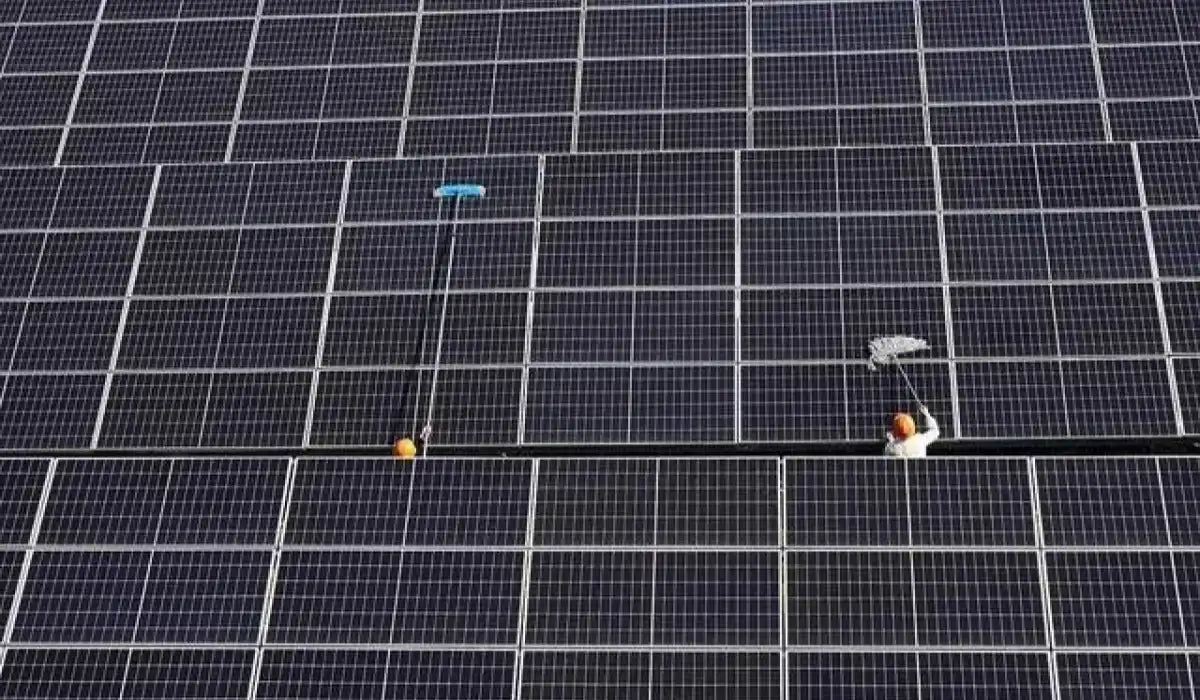
- Automatic cleaning
The automatic method on how to clean solar panel is to install the cleaning device on the photovoltaic module array, and realize the automatic cleaning by the device through the rotation of the motor controlled by the program. Or use a solar panel cleaning vehicle, which adds a free-arm cleaning brush to the tractor and is equipped with a water delivery nozzle to rinse with water while brushing.
The automatic cleaning machine can be operated in two ways: "with water" and "without water" according to the on-site environment. The equipment cost of automatic cleaning method is high.
① Cleaning trolley
At present, the cleaning equipment modified with engineering vehicles as the carrier has high power and relatively high efficiency.
The cleaning work has good pressure consistency and will not produce uneven pressure on the solar panels and cause cracks in the photovoltaic modules. Moreover, cleaning can be carried out by sweeping and washing modes. 10MWp uses 30 cubic meters of water to descale, which is equivalent to a 0.23mm light rain on the surface of a 22Km×3.5m solar panel array.

② Cleaning robot
In order to effectively improve the efficiency of cleaning dust on the surface of distributed solar power generation panels or home solar power system, intelligent cleaning robots are used for regular cleaning to completely remove dust and dirt on the surface of photovoltaic modules to improve power generation efficiency.
The method of how to clean solar panel with cleaning robot is to install a photovoltaic module cleaning robot for each row of photovoltaic modules in the power station (you can also install a line-feeding trolley, and there is a robot for multiple rows) to automatically and regularly clean the photovoltaic modules without any supervision. It can run its own photovoltaic components and power storage device, no external power supply is required.
At present, outdoor photovoltaic power stations commonly use the large-scale photovoltaic cleaning robot. This robot is a waterless rail-mounted robot with horizontal cleaning brushes.
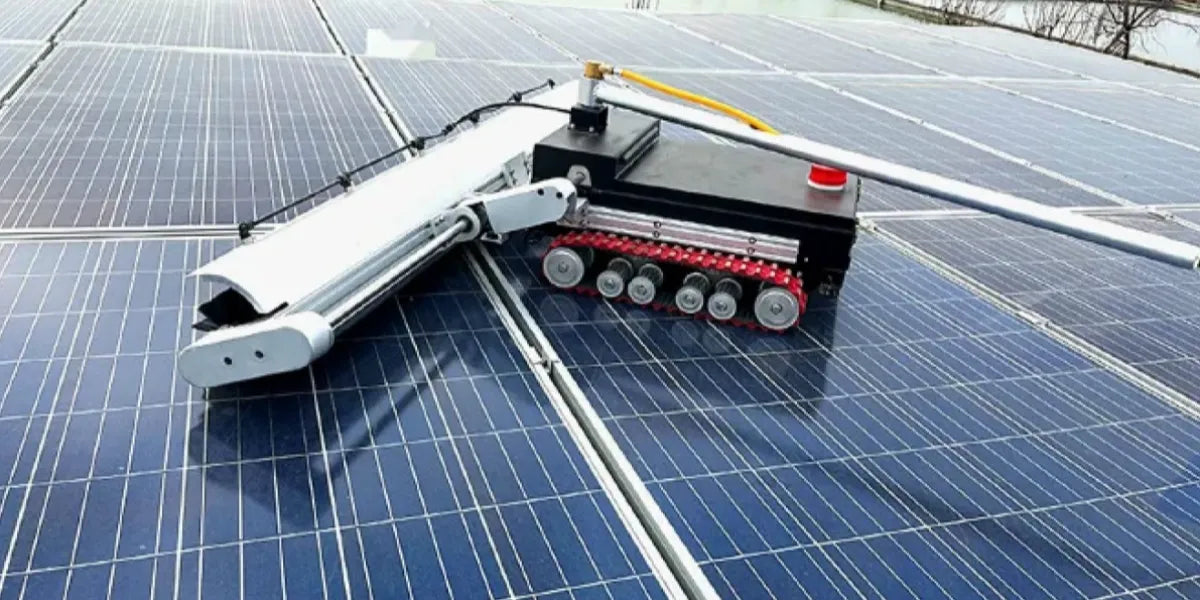
4. Comparison of different cleaning solutions
Each of the solar panel cleaning solutions mentioned above has its own limitations. Since the dust accumulation, water sources, and topography of power stations in various regions vary greatly, solutions on how to clean solar panel should also be adapted to local conditions. The advantages and disadvantages of each solution are compared below.
|
Item |
Manual cleaning |
Automatic cleaning |
||
|
Manual washing |
Manual dry cleaning |
Cleaning trolley |
Cleaning robot |
|
|
Cleaning efficiency |
Slow and low efficiency |
Fast and high efficiency |
||
|
Cleaning cost |
The initial investment cost is low, but the labor cost during operation is high. The water consumption is relatively low, about 1 ton of water is used for each cleaning of 1 megawatt |
The initial investment cost is low, but the labor cost during operation is high. |
The initial investment in cleaning equipment is too large. The water consumption is relatively high, about 5 tons of water is used for each cleaning of 1 MW. |
The initial investment in cleaning equipment is too large. Moreover, each string requires additional guide rails, power cables and control cables, resulting in the highest investment cost. But the operation cost is low. |
|
Application scenarios |
Applicable to roof photovoltaic power stations and ground photovoltaic power stations |
Applicable to ground photovoltaic power stations with flat terrain. Not suitable for uneven terrain and rooftop photovoltaic power stations. |
Suitable for large roof photovoltaic power stations, ground and water surface photovoltaic power stations. |
|
|
Advantages |
Less water consumption, low cost, convenient operation and maintenance, and low operating cost. |
Relatively low cost |
High cleaning efficiency and good cleaning effect. Use dust-repellent flexible materials that will not scratch the solar panels. |
The robot can work at night, with its own off grid storage batteries, provides external power without lightning, will not cause cracks in solar panels, and can save labor costs and water. |
|
Disadvantages |
It is difficult to ensure the consistency of the cleaning effect and the effect is not good; it is easy to cause wear and tear on the surface of the solar panel, which has a certain impact on the light transmittance and lifespan. It requires more operators, slow cleaning speed, and long cleaning cycle. |
The scope of application is small and is only suitable for flat ground photovoltaic power stations; operators need to control the system, otherwise the cleaning vehicles may not move in a straight line, and the pressure on the components is uneven, which can easily damage the components. |
Each string requires additional guide rails, which increases the load requirements on the roof; the equipment is prone to failure, and the later operation and maintenance workload is heavy; the equipment operation occupies a wide area, which has an impact on the installed capacity. |
|
Related posts: 12v 100ah deep cycle battery, 12v 6ah deep cycle battery, golf cart battery